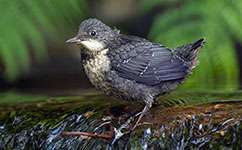Polluted rivers still a threat to city wildlife

In recent years, cleaner waters have heralded the return of a number of species to urban waterways right across Britain. But according to new research, carried out on a South Wales population of Eurasian dippers, this has brought them into contact with new pollutant threats.
'On the one hand, there's a good news story here,' says Professor Steve Ormorod, from Cardiff University, who co-led the study with Dr Christy Morrissey from the University of Saskatchewan.
'We've largely managed to get on top of our former problems of gross pollution, and we've cleaned up to such an extent that species like dippers, otters and Atlantic salmon have come back into our urban rivers.'
'But paradoxically, these same species are now being exposed to other more subtle pollutants. Wild birds are an important indicator of environmental well-being. What we've seen with dippers in South Wales is an expression of wider food-web contamination.'
'We need to know if populations, other species, or even people, are also at risk.'
The team measured concentrations of polychlorinated biphenyls (PCBs) and polybrominated diphenyl ethers (PBDEs) in 87 Eurasian dipper nests throughout South and Mid-Wales.
PCBs are largely a legacy of their historical use in hydraulic fluids, coolants and electrical equipment, while PBDEs are used as flame retardants. Many are now strictly regulated, with some banned outright.
But according to Ormerod, there is evidence and concern that some potentially toxic forms of PBDEs might still be increasing because of the ways that these complex chemicals are broken down in the natural environmen.
In urban nests, where pollutant levels tended to be high, chicks were smaller and lighter, hinting at weaker internal development.
There was also evidence that their hormones were altered, leading to fewer female chicks and a disturbance of the gender ratio across the urban population. One thyroid hormone was 43 per cent lower in urban chicks than in their rural counterparts.
As top predators, dippers are valuable monitors of river pollution, helping to assess whether urban contaminants are influencing wildlife reproduction and development.
Although the study was focussed on South Wales, Ormerod says similar accumulations of PCBs and PBDEs is likely in urban areas elsewhere in the UK and Europe. This could affect other species that rely on river food webs.
The RSPB welcomed the return of dippers to urban streams, but expressed concern at the continuing threat to wildlife from river contamination.
'The return of dippers to urban rivers is a fantastic outcome of pollution reduction in the UK,' says John Clark, the RSPB's Futurescape Officer.
'However, this study highlights the importance of birds as an indicator that some pollutants still persist in our rivers at harmful levels.'
'We need to work in partnership with water companies, regulators, statutory agencies and communities at a catchment scale to address those practices that continue to introduce damaging chemicals to our rivers.'
The research is published in the journal Environmental Toxicology and Chemistry.
More information: Christy A. Morrissey, David W.G. Stanton, Charles R. Tyler, M. Glória Pereira, Jason Newton, Isabelle Durance and Steve Ormerod, 'Developmental impairment in eurasian dipper nestlings exposed to urban stream pollutants', Environmental Toxicology and Chemistry, 2014.
Journal information: Environmental Toxicology and Chemistry
Provided by PlanetEarth Online
This story is republished courtesy of Planet Earth online, a free, companion website to the award-winning magazine Planet Earth published and funded by the Natural Environment Research Council (NERC).


















